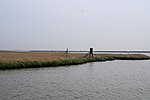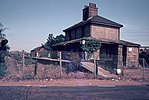Berney Arms railway station

Berney Arms railway station is on the Wherry Lines in the East of England, serving the settlement of Berney Arms on the Halvergate Marshes in Norfolk. It is 15 miles 71 chains (25.6 km) from Norwich and is the only station on a short stretch of single line between Reedham and Great Yarmouth. It is managed by Greater Anglia, which also operates all trains serving the station. The limited number of services timetabled to stop do so on request only.It is several miles from the nearest road and thus is accessible only by train, on foot, or by boat, as it is a relatively short walk from the River Yare, where private boats can moor. It was adopted in 2010 as part of the Station Adoption Scheme.
Excerpt from the Wikipedia article Berney Arms railway station (License: CC BY-SA 3.0, Authors, Images).Berney Arms railway station
Weavers Way, Broadland
Geographical coordinates (GPS) Address Nearby Places Show on map
Geographical coordinates (GPS)
| Latitude | Longitude |
|---|---|
| N 52.59 ° | E 1.6308333333333 ° |
Address
Weavers Way
NR30 1SB Broadland
England, United Kingdom
Open on Google Maps









